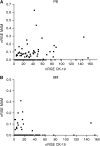Real-time RT-PCR detection of disseminated tumour cells in bone marrow has superior prognostic significance in comparison with circulating tumour cells in patients with breast cancer
- PMID: 16495933
- PMCID: PMC2361203
- DOI: 10.1038/sj.bjc.6602985
Real-time RT-PCR detection of disseminated tumour cells in bone marrow has superior prognostic significance in comparison with circulating tumour cells in patients with breast cancer
Abstract
This study assessed the ability of real-time reverse transcription-polymerase chain reaction (RT-PCR) analysis to detect disseminated epithelial cells (DEC) in peripheral blood (PB) and bone marrow (BM) of patients with breast cancer (BC). Detection of DEC in BM is an obvious choice in BC, but blood sampling is more convenient. The aim of this study was to evaluate whether the detection of DEC in either PB or BM predicts overall survival (OS). Peripheral blood and BM samples were collected from 148 patients with primary (stage M0, n=116/78%) and metastatic (stage M+, n=32/21%) BC before the initiation of any local or systemic treatment. Peripheral blood of healthy volunteers and BM of patients with a nonmalignant breast lesion or a haematological malignancy served as the control group. Disseminated epithelial cells was detected by measuring relative gene expression (RGE) for cytokeratin-19 (CK-19) and mammaglobin (MAM), using a quantitative RT-PCR detection method. The mean follow-up time was 786 days (+/- 487). Kaplan-Meier analysis was used for predicting OS. By taking the 95 percentile of the RGE of CK-19 (BM: 26.3 and PB: 58.7) of the control group as cutoff, elevated CK-19 expression was detected in 42 (28%) BM samples and in 22 (15%) PB samples. Mammaglobin expression was elevated in 20% (both PB and BM) of the patients with BC. There was a 68% (CK-19) and 75% (MAM) concordance between PB and BM samples when classifying the results as either positive or negative. Patients with an elevated CK-19 or MAM expression in the BM had a worse prognosis than patients without elevated expression levels (OS: log-rank test, P=0.0045 (CK-19) and P=0.025 (MAM)). For PB survival analysis, no statistical significant difference was observed between patients with or without elevated CK-19 or MAM expression (OS: log-rank test, P=0.551 (CK-19) and P=0.329 (MAM)). Separate analyses of the M0 and M+ patients revealed a marked difference in OS according to the BM CK-19 or MAM status in the M+ patient group, but in the M0 group, only MAM expression was a prognostic marker for OS. Disseminated epithelial cells, measured as elevated CK-19 or MAM mRNA expression, could be detected in both PB and BM of patients with BC. Only the presence of DEC in BM was highly predictive for OS. The occurrence of DEC in the BM is probably less time-dependent and may act as a filter for circulating BC cells. The use of either larger volumes of PB or performing an enrichment step for circulating tumour in blood cells might improve these results.
Figures


References
-
- Aerts J, Wynendaele W, Paridaens R, Christiaens MR, van den BW, van Oosterom AT, Vandekerckhove F (2001) A real-time quantitative reverse transcriptase polymerase chain reaction (RT–PCR) to detect breast carcinoma cells in peripheral blood. Ann Oncol 12: 39–46 - PubMed
-
- Bartek J, Bartkova J, Schneider J, Taylor-Papadimitriou J, Kovarik J, Rejthar A (1986) Expression of monoclonal antibody-defined epitopes of keratin 19 in human tumours and cultured cells. Eur J Cancer Clin Oncol 22: 1441–1452 - PubMed
-
- Berois N, Varangot M, Aizen B, Estrugo R, Zarantonelli L, Fernandez P, Krygier G, Simonet F, Barrios E, Muse I, Osinaga E (2000) Molecular detection of cancer cells in bone marrow and peripheral blood of patients with operable breast cancer. Comparison of CK19, MUC1 and CEA using RT–PCR. Eur J Cancer 36: 717–723 - PubMed
-
- Braun S, Pantel K (1998) Prognostic significance of micrometastatic bone marrow involvement. Breast Cancer Res Treat 52: 201–216 - PubMed
Publication types
MeSH terms
LinkOut - more resources
Full Text Sources
Medical
Research Materials

